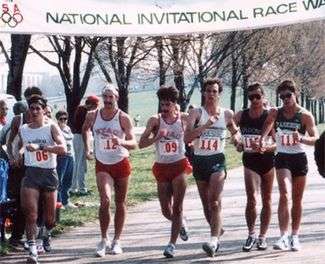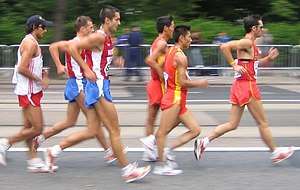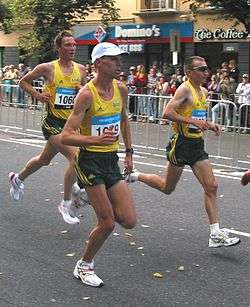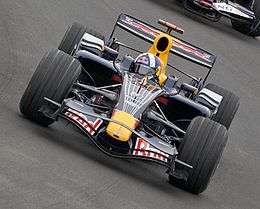Racewalking
Racewalking, or race walking, is a long-distance discipline within the sport of athletics. Although it is a foot race, it is different from running in that one foot must appear to be in contact with the ground at all times. This is assessed by race judges. Typically held on either roads or on running tracks, common distances range from 3,000 metres (1.9 mi) up to 100 kilometres (62.1 mi).
 Racewalkers at the U.S. World Cup Trials in 1987 | |
| Presence | |
|---|---|
| Country or region | World |
| Olympic | Yes |
There are two racewalking distances contested at the Summer Olympics: the 20 kilometres race walk (men and women) and 50 kilometres race walk (men only).[1] Both are held as road events. The biennial World Athletics Championships also features these three events, in addition to a 50 km walk for women. The IAAF World Race Walking Cup, first held in 1961, is a stand-alone global competition for the discipline and it has 10 kilometres race walks for junior athletes, in addition to the Olympic-standard events. The IAAF World Indoor Championships featured 5000 m and 3000 m race walk variations, but these were discontinued after 1993. Top level athletics championships and games typically feature 20 km racewalking events.
The sport emerged from a British culture of long-distance competitive walking known as pedestrianism, which began to develop the ruleset that is the basis of the modern discipline around the mid-19th century. Since the mid-20th century onwards, Russian and Chinese athletes have been among the most successful on the global stage, with Europe and parts of Latin America producing most of the remaining top level walkers.
Compared to other forms of foot racing, stride length is reduced; to achieve competitive speeds racewalkers must attain cadence rates comparable to those achieved by world-class 800 metres runners.[2]
Rules

There are only two rules that govern racewalking.[4][5] The first dictates that the athlete's back toe cannot leave the ground until the heel of the front foot has touched. Violation of this rule is known as loss of contact. The second rule requires that the supporting leg must straighten from the point of contact with the ground and remain straightened until the body passes directly over it. These rules are judged by the unaided human eye. Athletes regularly lose contact for a few milliseconds per stride, which can be caught on film, but such a short flight phase is said to be undetectable to the human eye.
Athletes stay low to the ground by keeping their arms pumping low, close to their hips. If one sees a racewalker's shoulders rising, it may be a sign that the athlete is losing contact with the ground. What appears to be an exaggerated swivel to the hip is, in fact, a full rotation of the pelvis. Athletes aim to move the pelvis forward and to minimize sideways motion in order to achieve maximum forward propulsion. Speed is achieved by stepping quickly with the aim of rapid turnover. This minimizes the risk of the feet leaving the ground. Strides are short and quick, with pushoff coming forward from the ball of the foot, again to minimize the risk of losing contact with the ground. World-class racewalkers (male and female) can average under four and five minutes per kilometre in a 20-km racewalk.[6]
Distances
_-_The_Winners_of_the_10%2C000_M_Walk.jpg)
Races have been walked at distances as short as 3 kilometres (1.9 mi)—at the 1920 Summer Olympics—and as long as 100 km (62.1 mi). The men's world record for the 50-mile race walk is held by Israeli Shaul Ladany, whose time of 7:23:50 in 1972 beat the world record that had stood since 1935.[7] The modern Olympic events are the 20 km (12.4 mi) race walk (men and women) and 50 km (31 mi) race walk (men only). One example of a longer racewalking competition is the annual Paris-Colmar which is 450 to 500 km.
Indoor races are 3000 m and 5000 m.
Judges
There are judges on the course to monitor form. Three judges submitting "red cards" for violations results in disqualification. There is a scoreboard placed on the course so competitors can see their violation status. If the third violation is received, the chief judge removes the competitor from the course by showing a red paddle. For monitoring reasons, races are held on a looped course or on a track so judges get to see competitors several times during a race. A judge could also "caution" a competitor that he or she is in danger of losing form by showing a paddle that indicates either losing contact or bent knees. No judge may submit more than one card for each walker and the chief judge may not submit any cards; it is his or her job only to disqualify the offending walker. Disqualifications are routine at the elite level, such as the famous case of Jane Saville, disqualified within sight of a gold medal in front of her home crowd in the 2000 Summer Olympics, or Yet Lyu, disqualified 20 meters before the finish line at the 2017 World Championships in Athletics.
Beginnings
Racewalking developed as one of the original track and field events of the first meeting of the English Amateur Athletics Association in 1880. The first racewalking codes came from an attempt to regulate rules for popular 19th-century long-distance competitive walking events, called pedestrianism. Pedestrianism had developed, like footraces and horse racing, as a popular working class British and American pastime, and a venue for wagering. Walkers organised the first English amateur walking championship in 1866, which was won by John Chambers, and judged by the "fair heel and toe" rule. This rather vague code was the basis for the rules codified at the first Championships Meeting in 1880 of the Amateur Athletics Association in England, the birth of modern athletics. With football (soccer), cricket, and other sports codified in the 19th century, the transition from professional pedestrianism to amateur racewalking was, while relatively late, part of a process of regularisation occurring in most modern sports at this time.
Olympics
Racewalking is an Olympic athletics (track and field) event with distances of 20 kilometres for both men and women and 50 kilometres for men only. Racewalking first appeared in the modern Olympics in 1904 as a half-mile walk in the 'all-rounder,' the precursor to the 10-event decathlon. In 1908, stand-alone 1,500m and 3,000m racewalks were added, and—excluding 1924—there has been at least one racewalk (for men) in every Olympics since. The women's racewalk became an Olympic event only in 1992, following years of active lobbying by female internationals. A World Cup in racewalking is held biennially, and racewalk events appear in the World Athletics Championships, the Commonwealth Games and the Pan American Games, among others.
World Race Walking Challenge
Since 2003, the IAAF has organised the IAAF Race Walking Challenge, an annual worldwide competition series in which elite athletes accumulate points for the right to compete in the IAAF Race Walking Challenge Final and to share over US$200,000 of prize money. The series of televised events takes place in several countries each year including Mexico, Spain, Russia and China.[8]
High school
Racewalking is sometimes included in high school indoor and outdoor track meets, the rules often more relaxed. The distances walked tend to be relatively short, with the 1500 m being the most commonly held event. Racing also occurs at 3 km, 5 km and 10 km, with records kept and annual rankings published.[9]
Top performers
Men
20 km
| Mark | Athlete | Nationality | Venue | Date | Ref |
|---|---|---|---|---|---|
| 1:16:36 | Yusuke Suzuki | Nomi, Ishikawa | March 15, 2015 | ||
| 1:16:43 # [10] | Sergey Morozov | Saransk | June 8, 2008 | ||
| 1:17:02 | Yohann Diniz | Arles, France | March 8, 2015 | ||
| 1:17:16 | Vladimir Kanaykin | Saransk | September 28, 2007 | ||
| 1:17:21 | Jefferson Pérez | Paris | August 23, 2003 | ||
| 1:17:22 | Paquillo Fernández | Turku | April 28, 2002 | ||
| 1:17:23 | Vladimir Stankin | Adler | February 8, 2004 | ||
| 1:17:25 | Bernardo Segura | Bergen | May 7, 1994 | ||
| 1:17:30 | Alex Schwazer | Lugano | March 18, 2012 | ||
| 1:17:33 | Nathan Deakes | Cixi City | April 23, 2005 | ||
| 1:17:36 | Zhen Wang | Taicang | March 30, 2012 | ||
| 1:17:38 | Valeriy Borchin | Adler | February 28, 2009 |
50 km
| Mark | Athlete | Nationality | Venue | Date | Ref |
|---|---|---|---|---|---|
| 3:32:33 | Yohann Diniz | Zurich | 15 August 2014 | [11] | |
| 3:34:14 | Denis Nizhegorodov | Cheboksary | 11 May 2008 | [12] | |
| 3:34:38 | Matej Tóth | Dudince | 21 March 2015 | [13] | |
| 3:35:47 | Nathan Deakes | Geelong | 2 December 2006 | ||
| 3:35:59 | Sergey Kirdyapkin | London | 11 August 2012 | ||
| 3:36:03 | Robert Korzeniowski | Paris | 27 August 2003 | ||
| 3:36:04 | Alex Schwazer | Rosignano Solvay | 11 February 2007 | ||
| 3:36:06 | Yu Chaohong | Nanjing | 22 October 2005 | ||
| 3:36:13 | Zhao Chengliang | Nanjing | 22 October 2005 | ||
| 3:36:20 | Han Yucheng | Nanjing | 27 February 2005 |
Women
20 km
As of June 2019
| Rank | Time | Athlete | Nationality | Date | Place | Ref |
|---|---|---|---|---|---|---|
| 1 | 1:23:391 | Elena Lashmanova | 9 June 2018 | Cheboksary | [14] | |
| 2 | 1:24:38 | Liu Hong | 6 June 2015 | A Coruña | [15] | |
| 3 | 1:24:47 | Elmira Alembekova | 27 February 2015 | Sochi | [16] | |
| 4 | 1:24:501 | Olimpiada Ivanova | 4 March 2001 | Adler | ||
| 5 | 1:24:56 | Olga Kaniskina | 28 February 2009 | Adler | ||
| 6 | 1:25:03 | Marina Pandakova | 27 February 2015 | Sochi | [16] | |
| 7 | 1:25:04 | Svetlana Vasilyeva | 27 February 2015 | Sochi | [16] | |
| 8 | 1:25:08 | Vera Sokolova | 26 February 2011 | Sochi | ||
| 9 | 1:25:09 | Anisya Kirdyapkina | 26 February 2011 | Sochi | ||
| 10 | 1:25:12 | Lü Xiuzhi | 20 March 2015 | Beijing |
1 : These times were achieved without the presence of international judges to officiate the competition or post-race doping tests, thus making them invalid for world record status. However, they are accepted as personal best marks for those athletes.
50 km
The women's 50 km walk is a new event, having been controversially added to the World Athletics Championships for the first time in 2017.[17]
As of May 2019:
| Rank | Time | Athlete | Nationality | Date | Place | Ref |
|---|---|---|---|---|---|---|
| 1 | 3:59:15 | Liu Hong | 9 March 2019 | Huangshan | [18] | |
| 2 | 4:03:51 | Li Maocuo | 9 March 2019 | Huangshan | [19] | |
| 3 | 4:04:36 | Liang Rui | 5 May 2018 | Taicang | [20] | |
| 4 | 4:04:50 | Eleonora Giorgi | 19 May 2019 | Alytus | [21] | |
| 5 | 4:05:46 | Júlia Takács | 19 May 2019 | Alytus | [21] | |
| 6 | 4:05:56 | Inês Henriques | 13 August 2017 | London | [22] | |
| 7 | 4:07:30 | Ma Faying | 9 March 2019 | Huangshan | [19] | |
| 8 | 4:08:58 | Yin Hang | 13 August 2017 | London | [22] | |
| 9 | 4:09:33 | Claire Tallent | 5 May 2018 | Taicang | [20] | |
| 10 | 4:10:59 | Monica Svensson | 21 October 2007 | Scanzorosciate |
In popular culture
In Malcolm in the Middle season 4 episode 'Malcolm holds his tongue' Hal gets into the sport and exposes his local park rival as 'nothing but a common jogger' by proving that both of his feet leave the ground at once every 4th step.
Racewalking is sometimes derided as a contrived or "artificial" sport.[2]
In the 1966 film Walk, Don't Run, Jim Hutton plays a racewalker competing in the Tokyo Olympics. Cary Grant and Samantha Eggar co-star.
In 1992 long-time Olympic commentator Bob Costas compared it to "a contest to see who can whisper the loudest".[23]
See also
- Fitwalking
- Pedestrianism
- Power walking
- Speed walking
- Summer Olympics
- Walking
References
- Mulkeen, Jon. "PREVIEW: WOMEN'S 50KM RACE WALK – IAAF WORLD RACE WALKING TEAM CHAMPIONSHIPS TAICANG 2018". IAAF Official Website. IAAF. Archived from the original on August 30, 2018. Retrieved August 30, 2018.
- Eulich, Whitney (August 3, 2012). "Wait... That's an Olympic Event?". Christian Science Monitor. Archived from the original on March 5, 2016. Retrieved August 25, 2016.
- Belson, Ken (August 10, 2012). "One Step at a Time? It's More Complicated Than That". The New York Times. Archived from the original on March 7, 2017. Retrieved August 28, 2016.
- "I.A.A.F.Rule 230". web.archive.org. May 9, 2008.
- "Archived copy". Archived from the original on March 22, 2010. Retrieved 2008-08-21.CS1 maint: archived copy as title (link)
- "100 Metres - men - senior - outdoor - 2016". Iaaf.org. Archived from the original on December 31, 2007. Retrieved August 28, 2016.
- "Shaul Ladany". Jewishsports.net. Archived from the original on May 12, 2013. Retrieved February 24, 2013.
- "Archived copy". Archived from the original on July 14, 2009. Retrieved 2009-07-18.CS1 maint: archived copy as title (link)
- "Home - The Home of High School Race Walking". Web.archive.org. January 2, 2009. Archived from the original on February 4, 2010. Retrieved 2016-08-28.CS1 maint: BOT: original-url status unknown (link)
- not ratified by IAAF because it didn’t fulfil the criteria of having the required three international judges present
- Zaccardi, Nick (August 15, 2014). "Yohann Diniz stops to celebrate before breaking 50km race walk world record". NBC Sports. Archived from the original on August 14, 2016. Retrieved August 25, 2016.
- "Official IAAF Race Results Cheboksary 2008". iaaf.org. Archived from the original on June 10, 2010. Retrieved August 11, 2012.
- Zuzana Trojakova (March 21, 2015). "Toth records third-fastest 50km race walk in history in Dudince". IAAF. Archived from the original on March 25, 2015. Retrieved March 22, 2015.
- "Russian Race Walking Championships 2018 Complete Results" (PDF). marciadalmondo.com. June 9, 2018. Retrieved June 28, 2018.
- "Liu breaks 20km race walk world record in La Coruna". IAAF. June 6, 2015. Retrieved June 6, 2015.
- "Russian Race Walking Championships 2015 Results". ARAF. February 27, 2015. Retrieved October 19, 2016.
- "The IAAF Achieves Gender Parity At Worlds, But Only For Five Women". Archived from the original on May 19, 2018. Retrieved May 18, 2018.
- Bob Ramsak (March 9, 2019). "FLASH - Liu breaks world 50km race walk record in Huangshan, cracking 4-hour barrier". IAAF. Retrieved March 9, 2019.
- Yang Yi (March 9, 2019). "Liu maintains dominance in women's race walk with new 50km world record". xinhuanet.com. Retrieved March 9, 2019.
- "50km Race Walk Results" (PDF). IAAF. May 5, 2018. Retrieved May 5, 2018.
- "50km Race Walk Results" (PDF). EAA. May 19, 2019. Retrieved May 26, 2019.
- "50km Race Walk Results" (PDF). IAAF. August 13, 2017. Retrieved August 13, 2017.
- Guinto, Joseph. "Golden Boy: Costas Now". American Way. Archived from the original on August 13, 2012. Retrieved August 8, 2012.
External links
| Wikimedia Commons has media related to Race walking. |
- Racewalk.com
- World Class Racewalking
- High School Race Walking
- Race Walking Record – News, photos and reports all about racewalking
- World Masters Race Walking Rankings
- Race Walk UK
- Race Walk Australia
- The Walking Site
- D. Guebey walking pages
- Swiss Walking Federation, official website
- Centurions History

